 |
Michiel Jansz. van Mierevelt -- Click Here
|
|
(Delft, 1567 - Delft 27 June 1641) was a Dutch Golden Age painter.
He was the son of a goldsmith, who apprenticed him to the copperplate engraver Hieronymus Wierix. He subsequently became a pupil of Willem Willemz and Augusteyn of Delft, until Anthonie van Montfoort (Houbraken calls him Antony Blokland), who had seen and admired two of Mierevelt's early engravings, Christ and the Samaritan and Judith and Holofernes, invited him to enter his school at Utrecht.
He registered as a member of the Guild of St. Luke in The Hague in 1625.Devoting himself first to still lifes, he eventually took up portraiture, in which he achieved such success that the many commissions entrusted to him necessitated the employment of numerous assistants, by whom hundreds of portraits were turned out in factory fashion. Today over 500 paintings are or have been attributed to him.The works that can with certainty be ascribed to his own brush are remarkable for their sincerity, severe drawing and harmonious color, but comparatively few of the two thousand or more portraits that bear his name are wholly his own handiwork. So great was his reputation that he was patronized by royalty in many countries and acquired great wealth. The king of Sweden and the count palatine of Neuburg presented him with golden chains; Albert VII, Archduke of Austria, at whose court he lived in Delft, gave him a pension; and Charles I vainly endeavoured to induce him to visit the English court.
Though Mierevelt is chiefly known as a portrait painter, he also executed some mythological pieces of minor importance. Many of his portraits have been reproduced in line by the leading Dutch engravers of his time. He died at Delft.
The Rijksmuseum in Amsterdam has the richest collection of Mierevelt's works, chief of them being the portraits of William, Philip William, Maurice, and Frederick Henry of Orange, and of the count palatine Frederick V. At the Mauritshuis in The Hague are the portraits of four princes of the house of Orange, of Frederick V as king of Bohemia, and of Louise de Coligny as a widow. Other portraits by him are at nearly all the leading continental galleries, notably at Brunswick (3), Gotha (2), Schwerin (3), Munich (2), Paris (Louvre, 3), Dresden (4), Berlin (2), and Darmstadt (3). The town hall of Delft also has numerous examples of his work.
|
|
 |
Michiel Coxie -- Click Here
|
|
Coxie also spelled Coxcie or Coxien, Latinised name Coxius (1499 - 3 March 1592) was a Flemish painter who studied under Bernard van Orley, who probably induced him to visit the Italian peninsula.
Coxie was born in 1499 in Mechelen in what was then the Duchy of Brabant. At Rome in 1532 he painted the chapel of Cardinal Enckenvoirt in the church of Santa Maria dell'Anima; and Giorgio Vasari, who knew him, says with truth that he fairly acquired the manner of an Italian. But Coxie's principal occupation was designing for engravers; and the fable of Psyche in thirty-two sheets by Agostino Veneziano and the Master of the Die are favorable specimens of his skill.
Returning to the Netherlands, Coxie greatly extended his practice in this branch of art. But his productions were till lately concealed under an interlaced monogram M.C.O.K.X.I.N. In 1539, Coxie returned to Mechelen, where he matriculated and painted the wings of an altarpiece for the chapel of the guild of St Luke. The centre of this altar-piece, by Jan Mabuse, represents Saint Luke the Evangelist, patron of painters, portraying the Virgin; the side pieces contain the Martyrdom of Saint Vitus and the Vision of St John the Evangelist in Patmos.
At van Orley's death in 1541 Coxie succeeded to the office of court painter to the Regent Maria of Austria, for whom he decorated the castle of Binche. He was subsequently patronized by Charles V, Holy Roman Emperor, who often coupled his works with those of Titian; by Philip II of Spain, who paid him royally for a copy of Jan van Eyck's Agnus Dei, and also commissioned two copies of Van der Weyden's Descent from the Cross from Coxie; and by Fernando Álvarez de Toledo, Duke of Alva, who once protected him from the insults of Spanish soldiery at Mechelen. At that time, Coxie also designed tapestries for the Brussels manufacturers. |
|
 |
Michiel Cocxie -- Click Here
|
|
Flemish Raphael , b. Mechlin, 1499- d. 1592 |
|
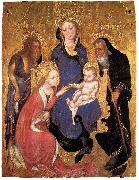 |
Michelino da Besozzo -- Click Here
|
|
Italian Early Renaissance Painter, active 1388-1450 |
|
 |
MICHELI Parrasio -- Click Here
|
|
Italian painter, Venetian school (before 1516 - 1578)
Italian painter and draughtsman. The natural son of a Venetian aristocrat, Salvador Michiel, he pursued his early training in the workshop of Titian and later in his career was associated with Paolo Veronese, who provided him with drawings for his paintings. He is known to have been in Rome before 1547. Micheli's earliest work is an altarpiece depicting the Virgin and Child with SS Lorenzo and Ursula (1535; Murano, S Pietro Martire), which was commissioned by Ursula Pasqualigo in memory of her deceased husband, the former Procurator Lorenzo Pasqualigo. There is also a Venus and Cupid (c. 1547; London, priv. col.) and a Lucrezia (c. 1547; London, Mond col.). In 1550 he married the daughter of a German baker. Several documented paintings have been destroyed or are untraced: the painting of Doge Lorenzo Priuli Accompanied by Ten Senators with Personifications of Fortune and Venice (1563), for which he received 225 ducats, was destroyed in the fire in the Doge's Palace of 1574. The work is known from a preparatory study (Berlin, Kupferstichkab.) and a contract of 22 October 1563. Five paintings known to have been in the Libreria Marciana that same year are also untraced. The large painting depicting the Adoration of the Dead Christ (Venice, S Giuseppe), signed and dated parrhasio Micheli dipinse nel 1573, includes a self-portrait. Micheli also painted portraits of Venetian noblemen (e.g. Girolamo Zane, Venice, Accademia; Tommaso Contarini, Venice, Doge's Palace) and associated with prominent men of letters including Paolo Giovio and Pietro Aretino. |
|
 |
Michele Rocca -- Click Here
|
|
(1671-died after 1751) was an Italian painter of the Baroque period. He was born at Parma and practised in Rome, and died some time after 1751. He was also called also Parmigiano the younger or Michele da Parma. He worked in the manner of Pietro da Cortona.
|
|
 |
MICHELE PANNONIO -- Click Here
|
|
Hungarian Early Renaissance Painter, ca.1400-1464
Painter, active in Italy. He was one of the most important painters at the court of Ferrara in the mid-15th century and contributed to the creation of an indigenous Ferrarese style of painting. Most of his works have been destroyed. He may have been born in Hungary, as his name implies. There are parallels between his style and that of contemporary painters working in Hungary, but nothing is known of his early career. The suggestion that he can be identified with a Michele dai Unii, paid in 1415 for painting a standard for Leonello d'Este, |
|
 |
michele di matteo lambertini -- Click Here
|
|
active in Bologna 1416-1469 |
|
 |
Michele da Verona -- Click Here
|
|
(Michele di Zenone) (born 1470) was an Italian painter of the Renaissance period.
He was born in Verona, a contemporary of Paolo Morando(Cavazzola), and may have assisted him in the decorative work for San Bernardino there. Inside the portal of San Stefano, Milan, is a large Crucifixion signed by him in 1500, and formerly in the Refectory of San Giorgio, of Verona. The same subject, dated by him in 1505, is in Santa Maria in Vanzo, Padua. In both pictures there is an imitation of the manner of Jacopo Bellini. In the church of Santa Chiara, Verona, are frescoes representing the Eternal, with Angels, Prophets, and the four Evangelists, dated 1509. Frescoes of later dates exist in the churches of Vittoria Nuova and Sant' Anastasia; while in the church of Villa di Villa, near Este, is a Madonna and Child, between SS. John the Baptist, Lawrence, Andrew, and Peter dated 1523.
|
|
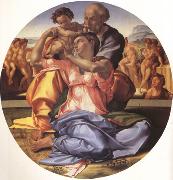 |
Michelangelo Buonarroti -- Click Here
|
|
b Caprese 1475 d Rome 1564
Born: March 6, 1475
Caprese, Italy
Died: February 18, 1564
Rome, Italy
Italian artist
Michelangelo was one of the greatest sculptors of the Italian Renaissance and one of its greatest painters and architects.
Early life
Michelangelo Buonarroti was born on March 6, 1475, in Caprese, Italy, a village where his father, Lodovico Buonarroti, was briefly serving as a Florentine government agent. The family moved back to Florence before Michelangelo was one month old. Michelangelo's mother died when he was six. From his childhood Michelangelo was drawn to the arts, but his father considered this pursuit below the family's social status and tried to discourage him. However, Michelangelo prevailed and was apprenticed (worked to learn a trade) at the age of thirteen to Domenico Ghirlandaio (1449?C1494), the most fashionable painter in Florence at the time.
After a year Michelangelo's apprenticeship was broken off. The boy was given access to the collection of ancient Roman sculpture of the ruler of Florence, Lorenzo de' Medici (1449?C1492). He dined with the family and was looked after by the retired sculptor who was in charge of the collection. This arrangement was quite unusual at the time.
Early works
Michelangelo's earliest sculpture, the Battle of the Centaurs (mythological creatures that are part man and part horse), a stone work created when he was about seventeen, is regarded as remarkable for the simple, solid forms and squarish proportions of the figures, which add intensity to their violent interaction.
Soon after Lorenzo died in 1492, the Medici family fell from power and Michelangelo fled to Bologna. In 1494 he carved three saints for the church of San Domenico. They show dense forms, in contrast to the linear forms which were then dominant in sculpture.
Rome
After returning to Florence briefly, Michelangelo moved to Rome. There he carved a Bacchus for a banker's garden of ancient sculpture. This is Michelangelo's earliest surviving large-scale work, and his only sculpture meant to be viewed from all sides.
In 1498 the same banker commissioned Michelangelo to carve the Piet?? now in St. Peter's. The term piet?? refers to a type of image in which Mary supports the dead Christ across her knees. Larger than life size, the Piet?? contains elements which contrast and reinforce each other: vertical and horizontal, cloth and skin, alive and dead, female and male.
Florence
On Michelangelo's return to Florence in 1501 he was recognized as the most talented sculptor of central Italy. He was commissioned to carve the David for the Florence Cathedral.
Michelangelo's Battle of Cascina was commissioned in 1504; several sketches still exist. The central scene shows a group of muscular soldiers climbing from a river where they had been swimming to answer a military alarm. This fusion of life with colossal grandeur henceforth was the special quality of Michelangelo's art.
From this time on, Michelangelo's work consisted mainly of very large projects that he never finished. He was unable to turn down the vast commissions of his great clients which appealed to his preference for the grand scale.
Pope Julius II (1443?C1513) called Michelangelo to Rome in 1505 to design his tomb, which was to include about forty life-size statues. Michelangelo worked on the project off and on for the next forty years.
Sistine Chapel
In 1508 Pope Julius II commissioned Michelangelo to decorate the ceiling of the chief Vatican chapel, the Sistine. The traditional format of ceiling painting contained only single figures. Michelangelo introduced dramatic scenes and an original framing system, which was his earliest architectural design. The chief elements are twelve male and female prophets (the latter known as sibyls) and nine stories from Genesis.
Michelangelo stopped for some months halfway along. When he returned to the ceiling, his style underwent a shift toward a more forceful grandeur and a richer emotional tension than in any previous work. The images of the Separation of Light and Darkness, and Ezekiel illustrate this greater freedom and mobility.
After the ceiling was completed in 1512, Michelangelo returned to the tomb of Julius and carved a Moses and two Slaves. His models were the same physical types he used for the prophets and their attendants in the Sistine ceiling. Julius's death in 1513 halted the work on his tomb.
Pope Leo X, son of Lorenzo de' Medici, proposed a marble facade for the family parish church of San Lorenzo in Florence to be decorated with statues by Michelangelo. After four years of quarrying and designing the project was canceled.
Medici Chapel
In 1520 Michelangelo was commissioned to execute the Medici Chapel for two young Medici dukes. It contains two tombs, each with an image of the deceased and two allegorical (symbolic) figures: Day and Night on one tomb, and Morning and Evening on the other.
A library, the Biblioteca Laurenziana, was built at the same time on the opposite side of San Lorenzo to house Pope Leo X's books. The entrance hall and staircase are some of Michelangelo's most astonishing architecture, with recessed columns resting on scroll brackets set halfway up the wall and corners stretched open rather than sealed.
Poetry
Michelangelo wrote many poems in the 1530s and 1540s. Approximately three hundred survive. The earlier poems are on the theme of Neoplatonic love (belief that the soul comes from a single undivided source to which it can unite again) and are full of logical contradictions and intricate images. The later poems are Christian. Their mood is penitent (being sorrow and regretful); and they are written in a simple, direct style.
Last Judgment
In 1534 Michelangelo left Florence for the last time, settling in Rome. The next ten years were mainly given over to painting for Pope Paul III (1468?C1549). |
|
 |
Michel-Ange Houasse -- Click Here
|
|
1680-1730
French
Michel Ange Houasse Gallery
Son of Rene-Antoine Houasse. He trained in his father's circle, becoming familiar with the academic teaching methods then fashionable in France and also in Italy, where he went with his father. In 1706 he joined the Acad?mie Royale de Peinture et de Sculpture in Paris, obtaining the rank of Academician in 1707 with the painting Hercules and Lichas (Tours, Mus. B.-A.). In Rome he probably became acquainted with the Marquis d'Aubigny, secretary to the powerful Princess Orsini, who was close to Philip V of Spain. The Spanish King already had the painter Henri de Favanne in his service in Madrid; Michel-Ange was recommended for work at the Spanish court by Count Jean Orry (1652-1719), the King's French finance minister, and arrived there in 1715. He had contact with the French artists at court and married the daughter of the French architect Rene Carlier. |
|
 |
Michel Sittow -- Click Here
|
|
(c.1469-1525) was a painter from Reval (now Tallinn, Estonia) who was trained in the tradition of Early Netherlandish painting. For most of his life, Sittow worked as a court portrait painter, for Isabella of Castille, the Habsburgs and others in Spain and the Netherlands. He was one of the most important Flemish painters of the era.
|
|
 |
Michel Gobin -- Click Here
|
|
painted Junger Mann mit Pfeife in 1681 |
|
 |
Michel Bouquet -- Click Here
|
|
(born 6 November 1925) is a French film actor. He has appeared in over 90 films since 1947. He was born in Paris, France.
|
|
 |
Michau, Theobald -- Click Here
|
|
Flemish Painter, 1676-1765 |
|
 |
Michael Zeno Diemer -- Click Here
|
|
painted The Ahırkapı Lighthouse in 1906 - 1907
|
|
 |
Michael Wolgemut -- Click Here
|
|
German Northern Renaissance Painter and Printmaker, ca.1434-1519,German painter and printmaker, was born and died in Nuremberg.Little is known of Wolgemut's private life. He trained with his father Valentin Wolgemut (who died in 1469 or 1470) and in 1472 he married the widow of his former apprentice-master, the painter Hans Pleydenwurff, whose son Wilhelm worked as an assistant, and from 1491 a partner, to his stepfather. Some consider Wilhelm Pleydenwurff a finer artist than Wolgemut, however he died in January 1494, when he was probably still in his thirties. Wilhelm's oeuvre remains unclear, though works in various media have been attributed to him. The importance of Wolgemut as an artist rests, not only on his own individual works, but also on the fact that he was the head of a large workshop, in which many different branches of the fine arts were carried on by a great number of pupil-assistants, including Albrecht Durer, who completed an apprenticeship with him between 1486-9. |
|
 |
Michael Willmann -- Click Here
|
|
(27 September 1630 - 26 August 1706) was a German painter. The Baroque artist became known as the "Silesian Raphael".
Willmann was born in Königsberg, Duchy of Prussia. He was educated by his father, the painter, Christian Peter Willmann. Michael went to the Dutch Republic in 1650 to learn from the masters, and he was inspired by the works of Rembrandt, Peter Paul Rubens, and Anthony van Dyck. For financial reasons he was unable to afford studying at the studio of a well-known painter.
After two years in the Netherlands, mostly spent in Amsterdam, Willmann returned to Königsberg, passed his master's examination, and began to travel. After visiting Danzig, Willmann went to Prague, where he stayed from 1653-55. He then spent about a year in Breslau. Willmann's first known paintings, commissioned by Abbot Arnold Freiberger of the Abbatia Lubensis abbey in Leubus, Lower Silesia, date from 1656. Leubus became the setting of much of Willmann's creativity.
From 1657-58 Willmann was in Berlin as the court painter of Frederick William, Elector of Brandenburg. He painted mythological scenes for the elector, presumably for his residence at Königsberg Castle. In 1660 Willmann returned to Leubus, which allowed him a large workshop.
Willmann's workship, modeled after those of the Dutch painters, quickly spread his fame. The extensive studio included his son Michael Leopold Willmann the Younger, his daughter Anna Elisabeth, and Anna Elisabeth's husband Christian Neuenhertz and son Georg Wilhelm Neunhertz. Willmann's studio also counted Johann Kretschmer from Glogau, Johann Jacob Eybelwieser from Breslau, the Cistercian Jacob Arlet from Gressau, and Willmann's stepson Johann Christoph Lischka.
Willmann became the leading painter of Silesia through his expressiveness, technical dexterity, and speed. Willmann worked on orders from the patriciate of Breslau, as well as churches and monasteries throughout Silesia, Bohemia, and Moravia. He received contracts for the Cistercian monasteries in Gressau, Heinrichau, Kamenz, Rauden, and Himmelwitz. With the assistance of his students and assistants, Willmann produced 500 paintings and frescos during his life. Numerous drawings of Willmann's were later used by engravers. |
|
 |
Michael Sweerts -- Click Here
|
|
Flemish
1618-1664
Michiel Sweerts (September 29, 1618 - 1664), also known as Michael Sweerts, was a Flemish painter of the Baroque period, active in Rome (1645-1656) in the style of the Bamboccianti. The Bamboccianti were known for depicting genre scenes of daily life.
Born in Brussels, he arrived in Rome in the mid 1640s, and rapidly moved into the circle of Flemish painters that had arrayed around Pieter van Laer, and that resided near Santa Maria del Popolo. In 1647, he attended meetings of the Accademia di San Luca, although not as a member. By 1659, he had returned to Brussels, where he joined the painter's guild.
He appears to have become mentally unstable in his last years. In Amsterdam, he joined the Jesuits as a "lay Brother" rather than a priest, and sailed from Marsaille to the East with a missionary group. Travelling to Jerusalem, and from there to Goa, where after causing tribulations to those around him, he died.
Sweerts is an enigmatic and difficult artist to categorize, since he seems to have absorbed a variety of influences to create an eclectic hybrid that can be described as a Netherlandish genre adaptation of an early tenebrist styles: a blend of Vermeer's genre of painting and Caravaggio-influenced full bodied figures.
|
|
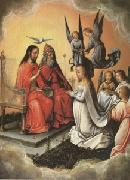 |
michael sittow formerly known as maitre Michiel -- Click Here
|
|
Reval(Estonia)ca 1468-1525/26 |
|
 |
michael pacher -- Click Here
|
|
Michael Pacher (c. 1435??August 1498) was an Austrian Tyrolean painter and sculptor active during the last quarter of the 15th century. His best-known work is the altarpiece at the church in the village of St. Wolfgang, Austria. This altarpiece contains scenes from the life of Jesus and the Virgin Mary. His influence is primarily North Italian, and his work shares characteristics with that of painters such as Andrea Mantegna; however, German influences are also evident in his work, especially in his wood sculpture. He was most active from 1462 until his death.
Pacher was one of the earliest artists to introduce the principles of Renaissance painting into Germany. He was a comprehensive artist with a broad range of skills: sculpting, painting, and architecture of complex wood and stone. He painted structures for altarpieces on a scale unparalleled in North European art. His work is frequently correlated with the work of Andrea Mantegna.
|
|
 |
Michael Dahl -- Click Here
|
|
Swedish Baroque Era Painter, 1659-1743,Swedish painter, active in England. He studied under Martin Hannibal (d 1741) and later with David Kl?cker Ehrenstrahl. In 1682 he travelled to London, where he became acquainted with Godfrey Kneller and Henry Tilson, and in 1685 he left for Europe with the latter, working briefly in Paris before proceeding to Venice and Rome, where they stayed for about two years. In Rome Dahl converted to Roman Catholicism and gravitated towards the circle of Christina, former Queen of Sweden, who sat for him (Grimsthorpe Castle, Lincs). He returned to England with Tilson via Frankfurt and arrived in London in 1689; he stayed in England for the remainder of his career. |
|
 |
Michael Conrad Hirt -- Click Here
|
|
painted Portrait of Anna Rosina Tanck, wife of the mayor of Lubecker in1642 |
|
 |
michael angelo rooker -- Click Here
|
|
Michael, Angelo, Rooker (1746 - 3 Mar 1801) was an English oil and watercolour painter of architecture and landscapes, illustrator and engraver. He was also the principal scene painter at the Haymarket Theatre. |
|
 |
Michael Ancher -- Click Here
|
|
Danish Painter, 1849-1927
He studied at the Kongelige Akademi for de Sk?nne Kunster, Copenhagen (1871-5), where his teachers Wilhelm Marstrand and Frederik Vermehren encouraged his interest in genre painting. He first visited Skagen in 1874 and settled there in 1880, having found that subject-matter drawn from local scenery was conducive to his artistic temperament. In Will he Manage to Weather the Point? (1880; Copenhagen, Kon. Saml.) several fishermen stand on the shore, evidently watching a boat come in. The firmly handled composition focuses on the group of men (the boat itself is invisible); each figure is an individual portrait that captures a response to the moment. Ancher's skill at grouping large numbers of figures with heroic monumentality compensates for his lacklustre colour sense. A change in his use of colour is noticeable in the works produced after an influential visit to Vienna in 1882; he was deeply impressed by the Dutch Old Masters at the Kunsthistorisches Museum, especially the Vermeers. Their effect on his painting can be seen in the Sick Girl (1883), |
|
 |
MEYTENS, Martin van -- Click Here
|
|
Dutch painter (b. 1695, Stockholm, d. 1770, Vienna).
was a Swedish-Austrian painter who has painted people of the royal Court of Austria such as Marie Antoinette, Maria Theresa of Austria, Francois III and his family, and many other royal paintings. His painting style has inspired many other painters to paint in a similar format. Martin van Meytens was born on June 16, 1695 and was later baptised in Stockholm, Sweden. He studied other great painter's works and in 1717 he had a great success in painting enamel paintings and miniatures, but later went on to greater task. In 1723 he began to paint large portraits of royal courts |
|
|
|
Meyer, Jeremiah -- Click Here
|
|
English Painter, 1735-1789
German enameller and painter, active in England. He was the son of a portrait painter at the court of W?rttemberg. He arrived in England c. 1749 and studied in London at St Martin's Lane Academy and then (1757-8) under Christian Friedrich Zincke; as a result of this training, much of Meyer's early work was painted on enamel. He exhibited (1760-67) at the Society of Artists and in 1761 was awarded its gold medal for a profile portrait of George III. In 1762 he became a naturalized Englishman. That year he was appointed miniature painter to Queen Charlotte and in 1764 painter in enamel to the King. Meyer was a founder-member of the Royal Academy and exhibited miniatures, enamels and watercolours there (1769-83). |
|
 |
Meunier, Constantin -- Click Here
|
|
Belgian Painter and Sculptor, 1831-1905
Belgian sculptor, painter and draughtsman. He was directed towards an artistic career by his elder brother, the engraver Jean-Baptiste Meunier (1821-1900). He entered the Acad?mie des Beaux-Arts, Brussels, in September 1845 and studied under the sculptor Louis Jehotte (1804-84) from 1848. In addition, in 1852 he attended the private studio of the sculptor Charles-Auguste Fraikin. Gradually he came to feel that sculpture, at least in the traditional form taught in Brussels, was incapable of providing an adequate vehicle for either exposition or expression. Still at the Academy, he transferred to painting, therefore, in 1853, and followed the courses given by Fran?ois-Joseph Navez, studying in the evenings at the Saint-Luc studio, with Charles De Groux. He became friends with Louis Dubois, F?licien Rops and other rebellious young artists who were to found the Soci?t? Libre des Beaux-Arts in Brussels in 1868. With these, Meunier was part of the realist avant-garde, while seeking out a path of his own in painting. It has been said that De Groux had a decisive influence on Meunier. The latter partly denied this and insisted that he had felt the need very early to practise an art that was more devoted to the masses, to the people. His interest in everyday life, in the experience and condition of man, can already be discerned in the sketches and studies he made during his stays in the Trappist monastery of Westmalle, near Antwerp, between 1857 and 1875. |
|
 |
Meulener, Pieter -- Click Here
|
|
Flemish painter
b. 1602, Antwerpen, d. 1654, Moisset |
|
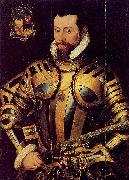 |
Meulen, Steven van der -- Click Here
|
|
Flemish Northern Renaissance Painter, active 1543-1568
Netherlandish painter active in England. He was a pupil of Willem van Cleve the younger (c. 1530-1564) in 1543 and was admitted to the Antwerp Guild of St Luke in 1552; by 1560 he had travelled to London, and he was naturalized in 1562. Van der Meulen brought with him a deep knowledge of the portrait style of Anthonis Mor. This sombre, shadowed style appealed to patrons at the English court who could not travel to Antwerp to sit to the greater artist. Early in 1561 an English merchant, John Dymoch, had visited Sweden in connection with negotiations for a marriage between Queen Elizabeth and Erik XIV, taking with him a Netherlandish painter described as 'Master Staffan', and it seems likely that this was van der Meulen. The King was much pleased with the resulting portrait of himself, for which he paid 100 daler |
|
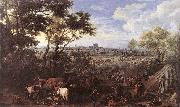 |
MEULEN, Adam Frans van der -- Click Here
|
|
Flemish painter (b. 1632, Bruxelles, d. 1690, Paris).
Flemish painter and draughtsman, active also in France. He was the eldest son of the seven children of Pieter van der Meulen and his second wife Marie van Steen Wegen. He went to study with Pieter Snayers, court painter in Brussels, on 18 May 1646, and in 1651 he became a master in the Brussels painters' guild. Probably soon after he married Catherina Huseweel. During the first 15 years of his career, the so-called Brussels period, he painted small-scale genre and history scenes with political and military events in the Baroque style of Sebastiaen Vrancx, Pieter Snayers and Jan Breughel the elder. Typical examples are a Cavalry Battle (1653; Geneva, Mus. A. & Hist.), a Ceremonial Entry into Brussels (1659; Kassel, Gemeldegal.), a General on Campaign (1660; Madrid, Prado) and a Hunting Scene |
|
 |
METSU, Gabriel -- Click Here
|
|
Dutch painter (b. 1629, Leiden, d. 1667, Amsterdam). |
|
 |
Metcalf, Willard Leroy -- Click Here
|
|
American Impressionist Painter, 1858-1925
American painter and illustrator. His formal education was limited, and at 17 he was apprenticed to the painter George Loring Brown of Boston. He was one of the first scholarship students admitted to the school of art sponsored by the Museum of Fine Arts, Boston, and took classes there in 1877 and 1878. After spending several years illustrating magazine articles on the Zuni Indians of New Mexico, he decided to study abroad and in 1883 left for Paris. There he studied at the Acad?mie Julian under Jules Lefebvre and Gustave Boulanger. During the five years he spent in France he became intimately acquainted with the countryside around the villages of Grez-sur-Loing and Giverny. He returned to America in 1888 |
|
 |
Meszoly, Geza -- Click Here
|
|
Hungarian Painter, 1844-1887 |
|
 |
Merson, Luc-Olivier -- Click Here
|
|
French Painter, 1846-1920
French painter and illustrator. He was the son of the painter and art critic Charles-Olivier Merson (1822-1902) and trained initially at the Ecole de Dessin in Paris under Gustave Adolphe Chassevent (1818-1901) and then at the Ecole des Beaux-Arts under Isidore-Alexandre-Augustin Pils. He made his d?but at the Salon in 1867 and won the Grand Prix de Rome in 1869 with the melodramatic work, the Soldier of Marathon (1869; Paris, Ecole N. Sup. B.-A.). As a prizewinner he then spent five years in Italy, where he was impressed and influenced by the works of the Italian Primitives, as is apparent in such works as St Edmund, King and Martyr (1871; Troyes, Mus. B.-A. & Arch?ol.), with its muted colours and rigid composition. In the Salon of 1875 he exhibited Sacrifice for the Country, St Michael, which had been commissioned as a design for a Gobelins tapestry for the Salle des Ev?ques in the Panth?on, Paris. Soon afterwards he was chosen to decorate the Galerie de St Louis in the Palais de Justice, Paris, with scenes from the life of Louis IX. This resulted in two large works, Louis Opening the Doors of the Gaols on his Accession and Louis Condemning Sire Enguerrand de Coucy (both 1877). He also used historical, often religious, subjects for his smaller-scale works, as in St Francis of Assisi Preaching to the Fish (1880; Nantes, Mus. B.-A.). |
|
 |
Merse, Pal Szinyei -- Click Here
|
|
Hungarian Painter, 1845-1920
was a Hungarian painter and politician. Born in Szinye??jfalu, Hungary (today Chminianska Nov?? Ves, Slovakia), he learned painting at the Academy of Fine Arts, Munich under Karl von Piloty. He was a friend of Wilhelm Leibl and Hans Makart. His are some of the earliest works of Impressionism in Hungary and Central Europe. At the 1873 World's Fair in Vienna he won a medal with his painting Bath House. Szinyei was also an active politician. He was elected to the parliament of Hungary where he fought for the modernization of art education. He died in February 2, 1920, just four month and two days before the Trianon treaty, in Jarovnice |
|
|
|
 |
Merian, Matthaus the Younger -- Click Here
|
|
Swiss, 1621-1687 |
|
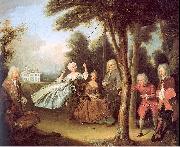 |
Mercier, Philippe -- Click Here
|
|
French Painter, ca.1689-1760
was a French painter and etcher, who lived principally and was active in England. He was born in Berlin of French extraction, the son of a Huguenot tapestry-worker. He studied painting at the Akademie der Wissenschaften of Berlin[1] and later under Antoine Pesne, who had arrived in Berlin in 1710. Later, he traveled in Italy and France before arriving in London??"recommended by the Court at Hannover"??probably in 1716. He married in London in 1719 and lived in Leicester Fields. He was appointed principal painter and librarian to the Prince and Princess of Wales at their independent establishment in Leicester Fields, and while he was in favor he painted various portraits of the Royalties, and no doubt many of the nobility and gentry. Of the Royal portraits, those of the Prince of Wales and of his three sisters, painted in 1728, were all engraved in mezzotint by Jean Pierre Simon, and that of the three elder children of the Prince of Wales by the John Faber Junior in 1744. This last was a typical piece of Mercier's composition, the children being made the subject of a spirited, if somewhat childish, allegory in their game of play. Prince George is represented with a firelock on his shoulder, teaching a dog his drill |
|
 |
MENGS, Anton Raphael -- Click Here
|
|
German Neoclassical Painter, 1728-1779
Painter and writer, brother of Theresia Concordia Mengs. His early career was at the Dresden court; thereafter he worked principally in Rome and Madrid, notably on the frescoes at the Villa Albani and the Palacio Real respectively. As an early exponent of Neo-classicism he produced some impressive classical and religious scenes, though he was most accomplished as a portrait painter. Under the influence of Johann Joachim Winckelmann he also wrote some theoretical works, of which the most important is the Gedanken ber die Schenheit und ber den Geschmack in der Malerey (1762). Although acclaimed during his lifetime
|
|
 |
Mendham, Robert -- Click Here
|
|
English, active 1821-1858 |
|
 |
Menard, Emile-Rene -- Click Here
|
|
French, 1862-1930 |
|
|
|
 |
MEMMI, Lippo -- Click Here
|
|
Italian Byzantine Style Painter, ca.1290-1347 |
|
 |
MEMLING, Hans -- Click Here
|
|
Netherlandish Northern Renaissance Painter, ca.1435-1494
South Netherlandish painter of German origin. Together with Dieric Bouts I and Hugo van der Goes, he was one of the most important exponents of the new artistic developments that flourished in the southern Netherlands in the 15th century in the wake of Jan van Eyck, the Master of Fl?malle and Rogier van der Weyden. Their principal innovation was to apply optic realism to devotional or mystical subjects. Although Memling lived in the turbulent period of transition from the Burgundian ruling house to that of the Habsburgs, little of this is evident in his work. His commissions were almost exclusively from rich burghers in Bruges (bankers, merchants and politicians) or churchmen and the occasional aristocrat. Often they were foreigners, especially Italians, who had political or financial connections with the town, whose central economic position was to last only a few decades longer. They had Memling paint their portraits, bust or full length, in devotional paintings or on altarpieces for their chapel in Bruges or back home. He seems not to have received official commissions (from the town council or court). An exceptional proportion of this oeuvre has survived. Besides about 20 altarpieces, often in several panels and of considerable size, |
|
 |
MELZI, Francesco -- Click Here
|
|
Italian Painter, 1493-1570
Italian painter and draughtsman. Belonging to a noble Lombard family, he began to attend the workshop of Leonardo da Vinci around 1508, during Leonardo's second visit to Milan. From that time on he was always associated with Leonardo, whose favourite pupil he became: he followed Leonardo to Rome in 1513 and moved with him to France in 1515, staying with him until his death in 1519. |
|
|
|
 |
Melozzo da Forli -- Click Here
|
|
1438-1494
Italian
Melozzo da Forli Location
Melozzo came, it is supposed, of a wealthy family named Ambrosi from Forl??. Nothing is known about his early years, and it is only a hypothesis that he formed at the Forlivese school of art, then ruled by Ansuino da Forl??, for they were both influenced by the Mantegna manner.
It has been said that he became a journeyman and color-grinder to some of the best masters, in order to prosecute his studies; this lacks confirmation. His presence his first mentioned in his birthplace in 1460 and again in 1464. Around this period, together with Antoniazzo Romano, frescoed the Bessarione chapel in the basilica dei Santi Apostoli in Rome. Melozzo presumably moved to in Urbino between 1465 and 1475: here he met the highly theoretical and mathematical Piero della Francesca, who profoundly influenced the Melozzo style and use of perspective. He should have also studied the architectures by Bramante and other Flemish painters then working for the duke Federico da Montefeltro: perhaps Melozzo worked with Justus of Ghent and Pedro Berruguete to the decoration of the studiolo of the famous Ducal Palace of the city.
In 1475 Melozzo transferred to Rome, though some authorities claim his presence in Rome ten (or five) years earlier to work in the Basilica di San Marco. In 1477 he finished his first major work in the new seat, a fresco now transferred to canvas and placed in the Pinacoteca Vaticana, representing the appointment of Bartolomeo Platina by Sixtus IV as librarian of the restored Vatican Library. In 1478 he was one of the original members of the academy of St Luke, founded by Sixtus IV to unite the main painters working in the city.
About 1480 Melozzo was commissioned by Pietro Riario to paint the vault of the apse in the basilica dei Santi Apostoli in Rome, his subject being the Ascension. The figure of Christ is so boldly and effectively foreshortened that it seems to burst through the vaulting; this fresco was taken down in 1711, and the figure of Christ is now in the Quirinal Palace; while some of the other portions, almost Raphaelesque in merit, are in the sacristy of St Peter: a hall in the Vatican Museums is designed for angels and apostles by Melozzo taken down the same fresco. Another work of the Roman period is an Annunciation that can still be seen in the Pantheon.
Melozzo last work in Rome is a chapel, now destroyed, in the church of Santa Maria in Trastevere. After the death of Sixtus IV in 1484 he moved from Rome to Loreto. Here he painted the fresco in the cupola of San Marco sacristy in the basilica della Santa Casa, commissioned by cardinal Girolamo Basso della Rovere. It is one of the first examples of a cupola decorated both with architectures and figures, with a profound influence from the Camera Picta by Mantegna.
In 1489 Melozzo returned in Rome. In this second period he probably drew some cartoons for the mosaics of Jesus blessing in the St. Helen chapel of the basilica of Santa Croce in Gerusalemme.
Pope Sixtus IV appoints Bartolomeo Platina prefect of the Vatican Library, c. 1477 (fresco) (Vatican Museums)Melozzo also painted the cupola of the Capuchin church at Forl??, destroyed in 1651; and it has been said that he executed at Urbino some of the portraits of great men (Plato, Dante, Sixtus IV, etc.) which are now divided between the Barberini Palace and the Campana collection in Paris. In 1493 he worked to some ceilings of the Palazzo Comunale of Ancona, which have gone lost. Eventually Melozzo moved to Forl??, where, together with his pupil Marco Palmezzano, decorated the Feo Chapel in the church of San Biagio, which was destroyed during World War II. The Pinacoteca of Forl?? houses a fresco by Melozzo, termed the Pestapepe, or Pepper-grinder, originally painted as a grocer sign; it is an energetic specimen of rather coarse realism, now much damaged. It is the only non-religious subject by Melozzo. |
|
 |
Melone, Altobello -- Click Here
|
|
Italian, active approx. 1516-1543 |
|
 |
Mellin, Charles -- Click Here
|
|
French Baroque Era Painter, 1597-1649 |
|
 |
Mellery, Xavier -- Click Here
|
|
Belgian Symbolist Painter, 1845-1921
Belgian painter, decorative artist and draughtsman. A gardener's son, he was brought up in a quiet suburb of Brussels, bordering the Parc Royal. He studied under the decorative artist Charles Albert (1821-89) and then, between 1860 and 1867, took a course in decorative design at the Brussels Acad?mie. In 1864 he joined the studio of Jean-Fran?ois Portaels to learn the techniques of modelling, painting from life and history painting. Having won the Belgian Prix de Rome in 1870, he travelled to Italy, where he was inspired by the work of Mantegna. His early work treated the working lives of the Belgian poor in a social realist manner influenced by Charles de Groux |
|
 |
Mellen, Mary Blood -- Click Here
|
|
American Painter, 1817-1882 |
|
 |
Meliore di Jacopo -- Click Here
|
|
Italian, active ca.1260-1271
|
|
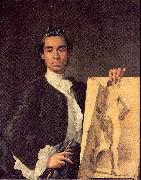 |
Melendez, Luis Eugenio -- Click Here
|
|
Spanish, born in Italy, approx. 1716-1780 |
|
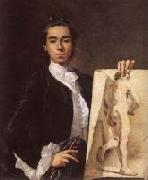 |
MELeNDEZ, Luis -- Click Here
|
|
Spanish Painter, 1716-1780
|
|
 |
Melchior de Hondecoeter -- Click Here
|
|
1635-1695
Dutch
Melchior de Hondecoeter Gallery
Melchior d'Hondecoeter (c. 1636 ?C April 3, 1695), Dutch animalier painter, was born at Utrecht, and died in Amsterdam. After the start of his career, he painted virtually exclusively bird subjects, usually exotic or game, in a park-like landscapes.
Being the grandson of Gillis d'Hondecoeter and son of Gijsbert d'Hondecoeter, as well as nephew of Jan Baptist Weenix, he was brought up by the last to the profession of painting, when his father died. Of Weenix we know that he married Gilles daughter Josina in 1638. Melchior was, therefore, also related to Jan Weenix. The latter told Arnold Houbraken, in his youth Melchior was extremely religious, praying very loud, so his mother and uncle doubted if they would have him trained as a painter.
In 1659 he was working in the Hague and became a member of the painters' academy at the Hague. In 1663 Hondecoeter married Susanne Tradel in Amsterdam. While she was captious and having her sisters living in their house, Hondecoeter spent much time in his garden or drinking in the tavern in the Jordaan. On the Lauriergracht, where he used to live, he was surrounded by art dealers and various painters. Later he moved to a house on Prinsengracht. In 1686 he bought a small countryhouse in Vreeland. Hondecoeter died in the house of his daughter Isabel in Warmoesstraat but was buried in Westerkerk near his house. His inventory lists a small gallow, to keep birds in the right position, and several paintings of Frans Snyders.
Melchior began his career with a different speciality from that by which he is usually known. Mr de Stuers affirms that he produced sea-pieces. One of his earliest works is a "Tub with Fish," dated 1655, in the gallery of Brunswick. But Melchior soon abandoned fish for fowl. He acquired celebrity as a painter of birds only, which he represented not exclusively, like Johannes Fyt, as the gamekeeper's perquisite after a day's shooting, or stock of a poulterer's shop, but as living beings with passions, joys, fears and quarrels, to which naturalists will tell us that birds are subject. Without the brilliant tone and high finish of Fyt, his Dutch rival's birds are full of action; and, as Burger truly says, "Hondecoeter displays the maternity of the hen with as much tenderness and feeling as Raphael the maternity of Madonnas." |
|
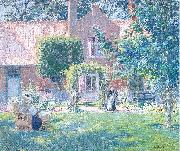 |
Melchers, Gari Julius -- Click Here
|
|
American Painter, 1860-1932 |
|
|
|
 |
Meindert Hobbema -- Click Here
|
|
1638-1709
Dutch
Meindert Hobbema Galleries
In the exercise of his craft Hobbema was patient beyond all conception. It is doubtful whether any one ever so completely mastered as he did the still life of woods and hedges, or mills and pools. Nor can we believe that he obtained this mastery otherwise than by constantly dwelling in the same neighbourhood, say in Guelders or on the Dutch Westphalian border, where day after day he might study the branching and foliage of trees and underwood embowering cottages and mills, under every variety of light, in every shade of transparency, in all changes produced by the seasons. Though his landscapes are severely and moderately toned, generally in an olive key, and often attuned to a puritanical grey or russet, they surprise us, not only by the variety of their leafage, but by the finish of their detail as well as the boldness of their touch. With astonishing subtlety light is shown penetrating cloud, and illuminating, sometimes transiently, sometimes steadily, different portions of the ground, shining through leaves upon other leaves, and multiplying in an endless way the transparency of the picture. If the chance be given him he mirrors all these things in the still pool near a cottage, the reaches of a sluggish river, or the swirl of the stream that feeds a busy mill. The same spot will furnish him with several pictures. One mill gives him repeated opportunities of charming our eye; and this wonderful artist, who is only second to Ruisdael because he had not Ruisdael's versatility and did not extend his study equally to downs and rocky eminences, or torrents and estuaries - this is the man who lived penuriously, died poor, and left no trace in the artistic annals of his country. It has been said that Hobbema did not paint his own figures, but transferred that duty to Adriaen van de Velde, Lingelbach, Barendt Gael, and Abraham Storck. As to this much is conjecture. |
|
 |
MEI, Bernardino -- Click Here
|
|
Italian painter, Roman school (b. 1612, Siena, d. 1676, Roma)
Italian painter, draughtsman and printmaker. His early art drew on a variety of sources, which included the naturalism of Rutilio Manetti and Francesco Rustici, the descriptive realism of the engraver Giuliano Periccioli (d 1646) and the Baroque of Raffaelle Vanni. Mei's interests even embraced 16th-century Sienese art. This stylistic variety is evident in his first known works, such as a bier (Casole d'Elsa, Collegiata), three signed miniatures in the Libro dei leoni (1634; Siena, Pal. Piccolomini, Archv Stato) and frescoes of scenes from the Life of St Bernard (1639; Siena, oratory of S Bernardino). His experimental approach is also displayed in such works as the Annunciation (Siena, Mus. Semin. Montarioso), which may be dated between the mid-1630s and the early 1640s. Mei's early maturity is marked by a conscious return to the naturalism of Manetti, enriched with a Baroque pathos and soft, fluid brushwork, as in the St Peter in Prison Awoken by the Angel and St Peter Freed by the Angel (both Siena; Conservatori Femminili Riuniti). His interest in both naturalism and the Baroque made him responsive to the art of Mattia Preti, possibly seen in Rome, as in the Beheading of St John the Baptist (1647; Siena, oratory of S Giovannino in Pantaneto) and the frescoes of scenes from the Life of St Roch and Life of St Job (1648; Siena, S Rocco), |
|
 |
Mednyanszky, Laszlo -- Click Here
|
|
Hungarian, 1852-1919
Ladislaus Josephus Balthasar Eustachius Mednyenszky was a Hungarian painter in the Impressionist tradition. Despite an aristocratic background, he spent most of his life moving around Europe working as an artist. Mednyenszky spent considerable periods in seclusion but mingled with people across society - in the aristocracy, art world, peasantry and army - many of whom became the subjects of his paintings. His most important works depict scenes of nature and poor, working people, particularly from his home region in Upper Hungary. Medny nszky was born in Beck, the Kingdom of Hungary (now Beckov in Slovakia), to Eduard Mednyenszky and Maria Anna Mednyenszky, (nee Szirmay) both from landowning families. Mednyenszky's family moved in 1861 to the chateau of his grandfather, Baltazer Szirmay, at Nagyőr (Strežky), near Szepesbela (Spišsk Bele) in north-eastern Hungary. This was to be the setting for many of his works. Medny nszky met the Austrian artist Thomas Ender in 1863 when Ender visited the chateau at Nagyőr. Ender took an interest in Mednyenszky's early efforts at drawing, lending his assistance to improve Mednyenszky's skills. Mednyenszky attended a grammar school in K??smerk (Kežmarok), near his home, then attended the Akademie der Bildenden Kenste (Academy of Fine Arts) in Munich in 1872 - 1873. Dissatisfied in Munich, he moved to Paris to attend the École des Beaux-Arts. After the death of his professor, Isidore-Alexandre Augustin Pils, in 1875, Mednyenszky left the École and began practicing independently from Montmartre. Mednyenszky returned to Nagyőr after 1877 to continue painting, and subsequently travelled widely in Europe, between his childhood homes in Upper Hungary and Budapest, Vienna, Paris and beyond. Mednyenszky visited the Szolnok artists' colony in the autumn of 1877 and Italy in 1878. His mother died in 1883, after which he lived in seclusion in Nagyőr. He returned to Nagyőr in 1887 to help deal with an outbreak of cholera but soon fell ill himself, with pneumonia. He spent much of 1889-1892 in Paris and returned regularly to Nagyőr until 1900. |
|
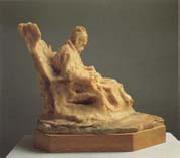 |
Medardo Rosso -- Click Here
|
|
1858 Turin-1928 Milan,was an Italian sculptor. He is thought to have developed the Post Impressionism style in sculpture along with Auguste Rodin. Medardo Rosso was born in Turin, Italy, in 1858, the son of the city stationmaster. Later his family mover to Milano (Milan). As a child Rosso played hooky from school to visit a monument mason who taught him to handle a chisel and hammer. This distressed and angered his parents. At the age of 23, after a period of military service as unsatisfactory as his home life, he enrolled at the Berea Academy in Milano, where he learned to draw classical statues and copy them in gesso. But academic art appeared to him entirely artificial, unrelated to the world around him. Before long he helped to organize the Berea students into demanding life models for the drawing classes. As a result of his revolutionary behavior he was expelled from the school. He moved to Rome, where he lived in great poverty, sleeping among the ruins of the Colosseum. To the end of his life Rosso battled unremittingly against the academicians. What absorbed, even obsessed, him was the problem of interpreting life itself. In 1882, some time before he saw any Impressionist paintings, he produced his fully impressionistic sculptures, The Street Singer and Lovers under the Lamplight. In 1884 some friends arranged an exhibition for him in Paris, where he lived for a time in a cheap boarding-house. |
|
|
|
 |
Meade, Francis -- Click Here
|
|
American, Approx. 1807-1870 |
|
 |
MAZZOLINO, Ludovico -- Click Here
|
|
Italian Painter, 1480-1528
.Italian painter. He may have served an apprenticeship with Ercole de' Roberti (Morelli) before he left Ferrara to study in Bologna with Lorenzo Costa (i). The earliest surviving documentation is from 20 May 1504, when he received a first payment for frescoes (destr. 1604) in eight chapels in S Maria degli Angeli, Ferrara, commissioned by Ercole I d'Este, Duke of Ferrara and Modena. Between 1505 and 1507 he was paid for works, presumably decorative, in the Este guardaroba and the camerini of the Duchessa Lucrezia Borgia in Ferrara Castle (untraced). His first surviving dated painting is the triptych of the Virgin and Child with SS Anthony and Mary Magdalene |
|
 |
MAZZOLA BEDOLI, Girolamo -- Click Here
|
|
Italian painter, Parma school (b. 1500, Viadana, d. ca. 1569, Parma) |
|
 |
MAZO, Juan Bautista Martinez del -- Click Here
|
|
Spanish Baroque Era Painter, ca.1612-1667 |
|
 |
Mazo, Juan Bautista -- Click Here
|
|
Spanish Baroque Era Painter, ca.1612-1667 |
|
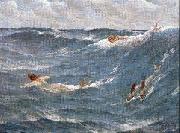 |
Maynard, George Willoughby -- Click Here
|
|
American, 1843-1923
American figure, marine, and mural painter, b. Washington, D.C., studied at the National Academy of Design and in Florence and Antwerp. Maynard created decorations for the Library of Congress and the old Metropolitan Opera House, New York City. |
|
 |
Maximilien Luce -- Click Here
|
|
Maximilien Luce (March 13, 1858 - February 6, 1941) was a French Neo-impressionist artist. A printmaker, painter, and anarchist, Luce is best known for his pointillist canvases. He grew up in the working class Montparnasse, and became a painter of landscapes and urban scenes which frequently emphasize the activities of people at work. He was a member of the Groupe de Lagny with Leo Gausson, Émile-Gustave Cavallo-Peduzzi and Lucien Pissarro.
|
|
 |
Maxime Maufra -- Click Here
|
|
was a French landscape and marine painter, etcher and lithographer.
Maufra first began painting at 18. He was encouraged to do so by two artists from Nantes: the brothers Leduc. However, he didnet fully embrace his painting career right away. Being a businessman, he only painted on his spare time from 1884 to 1890. During this time, Maufra discovered the work of the Impressionists and was able to display his works at the Paris Salon of 1886. In 1890, Maufra decided to give up commerce and to become a full-time painter. He left Nantes for Brittany, where he was able to meet Paul Gauguin and Paul Serusier. Maufra had his first solo exhibition in Paris in 1894, at Le Barc de Toutteville. Returning from Brittany, Maufra was the first painter to take up residence in The Bateau-Lavoir, a famous Parisian residence for artists.
In his paintings, Maufra sometimes quoted the pointillisit technique of Pissarro or Sisley, and also took from the strong colors and powerful drawing of the Pont Aven school. However, Maufra stayed an independent artist his all life through, and dedicated his art to recording the beauty of nature.
|
|
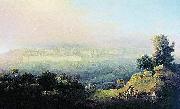 |
Maxim Nikiforovich Vorobiev -- Click Here
|
|
(1787-1855) was a Russian Romantic landscape painter.
Vorobiev was born into the family of a soldier, who on retirement became a guard in the Academy of Arts in St. Petersburg. There, Maxim was admitted in 1798 where he initially studied architecture but graduated as a landscape painter in 1809.
|
|
 |
Max, Gabriel Cornelius von -- Click Here
|
|
Czechoslovakian, 1840-1915
Painter, illustrator and teacher, nephew of (1) Emanuel Max. He studied at the Academy of Fine Arts, Prague (1855-8), and the Akademie der Bildenden K?nste, Vienna (1858-61), and under Karl Theodor von Piloty at the Akademie der Bildenden K?nste, Munich (1863/4-7). He settled in Munich, where he opened a private school of painting in 1869. His paintings and book illustrations of the second half of the 1860s show an affinity with the late Romanticist movement. He illustrated works of German literature by Wieland, Lenau and Schiller, as well as producing illustrations for Goethe's Faust (1867-8; Prague, N.G., Kinsky Palace). As well as literary and even musical sources, religious themes frequently occur in his work, including his first great success, the Crucifixion of St Julie (1867; ex-Sotheby's, London, 1976). In numerous female figures and portraits Max explored the tension between the inner state and the charm of the physical appearance or surroundings of his subjects. His interest in the artistic perception of relationships between physical reality and the spiritual world led him to a study of anthropology and contemporary occultism and mysticism, as in his portraits of the Seer of Prevorst |
|
 |
Max Uth -- Click Here
|
|
painted Landsitz in der Mark in 1900 |
|
 |
Max Slevogt -- Click Here
|
|
German Impressionist Painter, 1868-1932
German painter, printmaker and illustrator. His father, adjutant and friend of the future Prince Regent, Luitpold (1821-1912), died when Slevogt was just two years old. His mother moved to Werzburg, where he spent his schooldays. Even in his childhood and adolescence, family connections brought Slevogt to Pfalz, to an aunt in Landau and to the Finkler family in Neukastel. Initially he had planned to become a musician, but he began to study painting at the Akademie der Bildenden Kenste in Munich in 1885. His fellow students included Gabriel von Hackl (1843-1926), Karl Raupp (1837-1918), Ludwig Herterich (1856-1932) and Wilhelm von Diez (1839-1907). In 1889 he spent a term at the Academie Julian in Paris. At that time Impressionism had very little effect on him. Following a trip to Italy in 1890 with the painter Robert Breyer (1866-1941) who had befriended him at the Akademie, he began to work independently as a painter in Munich. In 1893 he participated in the first exhibition of the newly founded Munich Secession, exhibiting Wrestling School (1893; Edenkoben, Schloss Villa Ludwigshehe); the judges wanted to refuse this painting as immoral since its entwined and naked men caused offence. In the following years his paintings often appeared harsh and non-academic to conservative Munich circles. At this time Slevogt also made contributions to the journals Jugend and Simplizissimus, which were significant in the development of his graphic work. |
|
 |
Max Liebermann -- Click Here
|
|
German Impressionist Painter, 1847-1935
Max Liebermann (July 20 1847 ?C February 8 1935) was a German painter and printmaker in etching and lithography.
The son of a Jewish businessman from Berlin, Liebermann first studied law and philosophy at the University of Berlin, but later studied painting and drawing in Weimar in 1869, in Paris in 1872, and in the Netherlands in 1876-77. During the Franco-Prussian War (1870?C71), Liebermann served as a medic with the Order of St. John near Metz. After living and working for some time in Munich, he finally returned to Berlin in 1884, where he remained for the rest of his life. He was married in 1884 to Martha Liebermann (1857-1943, see portrait by Anders Zorn).
Together with Lovis Corinth and Max Slevogt, Liebermann became an exponent of German Impressionism. He used his own inherited wealth to assemble an impressive collection of French Impressionist works. He later chose scenes of the bourgeoisie, as well as aspects of his garden near Lake Wannsee, as motifs for his paintings. In Berlin, he became a famous painter of portraits; his work is especially close in spirit to Édouard Manet.
"Boys Bathing" Neue PinakothekFrom 1899 to 1911 he led the premier avant-garde formation in Germany, the Berliner Secession. Beginning in 1920 he was president of the Prussian Academy of Arts. In 1933 he resigned when the academy decided to no longer exhibit works by Jewish artists. While watching the Nazis celebrate their victory by marching through the Brandenburg Gate, Liebermann was reported to have commented: "Ich kann gar nicht so viel fressen, wie ich kotzen möchte" ("I could not eat as much as I would like to vomit.")
On 30 April 2006, the Max Liebermann Society opened a permanent museum in the Liebermann family's villa in Berlin-Wannsee. The artist's wife, Martha Liebermann, was forced to sell the building in 1940. In 1943 she committed suicide in the family home, Haus Liebermann, hours before police came to deport her to Theresienstadt concentration camp. |
|
 |
Max Kurzweil -- Click Here
|
|
Maximilian Franz Viktor Zdenko Marie Kurzweil (12 (13?) October 1867 Bisenz - 9 May 1916 Vienna) was an Austrian painter and printmaker. He moved near Vienna in 1879.
|
|
 |
Max Koch -- Click Here
|
|
(born July 17, 1854 - April 1, 1925) was a German-born Australian botanical collector.
Born in Berlin, Koch was apprenticed to a merchant's office, but, not liking the work, joined the crew of a Glasgow-based sailing ship at Bremerhaven. He left it at Port Augusta, South Australia in April 1878, taking work at a wheat farm. Later he moved to Mount Lyndhurst sheep station, where he remained for many years. Around 1896 he began serious botanical collecting.
Koch visited Germany around 1902-1903, then returned to Australia, and in 1904 moved to the extreme south-west of Western Australia, where he spent the next 17 years working in the timber industry. By that time he had a large family, and he supplemented his income by plant specimens, and, in his later years, seed. He died at Pemberton, Western Australia in 1925
|
|
 |
Max Klinger -- Click Here
|
|
German Symbolist Painter and Sculptor, 1857-1920
German painter, printmaker, sculptor and writer. He was one of the most versatile German artistic personalities of the turn of the 20th century and was especially celebrated for his cycles of prints, which were influential. |
|
 |
Max Joseph Wagenbauer -- Click Here
|
|
Maximilian Joseph Wagenbauer (1775 Grafing - 1829 Munich), was a Bavarian artist.
After finishing school, Wagenbauer attended drawing classes in Munich, under Johann Jakob Dorner the Elder (1741-1813). At the turn of the 19th century he was producing mostly Neo-Classical watercolour landscapes. He served in the military from 1797 to 1801, receiving a royal artist's annuity after his service through the influence of Johann Christian von Mannlich (1741-1822), architect and general building director of the dukes of Zweibre-ken. A condition of the royal stipend was that he produce paintings. He was appointed artist to the court and cabinet in 1802 and Inspector of the Royal Paintings Gallery in 1815. Wagenbauer focused increasingly on oil painting after 1810 and enjoyed the patronage of Maximilian I Joseph of Bavaria, who in 1811 commissioned him, Cantius Dillis (1779-1856) and Johann Jakob Dorner the Younger (1775-1852) to decorate the banquet hall at Schloss Nymphenburg with large paintings of Bavarian lakes. |
|
|